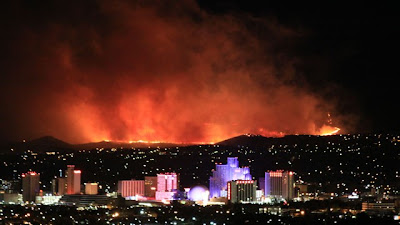The following entry was originally published on January 5th, and was written by JFSP Communications Director Tim Swedburg.
- - -
37 Year Journey for Safety
My first permanent job with the Forest Service was as a crew member on the Palomar Hotshots on the Cleveland National Forest in 1975. We learned through the telling of stories by our foremen and superintendents with a large dose of practical experience. I hope you will take a few moments to allow me to tell a story that means a lot to me and I hope to you as well.
The Cleveland had its share of fatalities starting with the Inaja Fire that resulted in the 10 Standard Firefighting orders. My engine foreman Red Wilson survived the Decker Fire on the Ortega Highway of the Trabuco District. The Loop Fire tragedy on the Angeles changed how we think about downhill line construction.
From the 1970’s fires in southern California, research developed Firescope which became the Incident Command System first deployed on the Pacoima Fire. In 1975, Clive Countryman wrote a paper called “The Nature of Heat” (pdf).
Although I went to school at Humboldt State University, there were no classes in wildland fire science. This stuff was new! The Nature of Heat was written in understandable language with numerous illustrations. Just the kind of publication a Hotshot crew could use.
In 1978, Carl C. Wilson and James C. Sorenson wrote a pamphlet titled “Some Common Denominators of Fire Behavior on Tragedy and Near-Miss Forest Fires (pdf)”. This work forever changed the discussions about wildland firefighter safety. Dick Rothermel’s Spread Model, Behave and the Ti59 soon followed and we could model fires in the field. Paul Gleason repackaged how we think about fire safety with LCES – Lookouts, Communications, Escape Routes and Safety Zones. And Brett Butler has helped us understand how big a safety zone really needs to be and that rock pile I used so many times may not have been really safe.
In spite of these and many other pieces of research, fire fatalities continue. An often heard phrase in these near-miss and fatal fires is, “the fire behavior was unexpected” or “it blew up.” I’m pleased to announce new research insight for wildland firefighters about Extreme Fire Behavior with the JFSP sponsored publication of Synthesis of Knowledge of Extreme Fire Behavior: Volume 1 for Fire Managers (pdf).
An even more detailed second volume will be published soon. I ask that all wildland firefighters download the document. Spend time this winter learning about this subject that is central to everything we do. The Fire Behavior Committee will make changes in fire training based on this information and I urge due speed.
Most importantly tell your own stories with your crews, unit, or post your thoughts here on firescience.gov. All this month we will post the “classics” about fire behavior on our website and I hope you find them useful.
 Palomar Hotshots during the Gamboa Fire in the Los Padres National Forest 1980
Palomar Hotshots during the Gamboa Fire in the Los Padres National Forest 1980
Experience may be the best teacher, but it helps a lot to have the wisdom of science on your side too.
Be Safe,
Tim Swedberg
Communications Director
Firescience.gov
Joint Fire Science Program
 Palomar Hotshots during the Gamboa Fire in the Los Padres National Forest 1980
Palomar Hotshots during the Gamboa Fire in the Los Padres National Forest 1980




